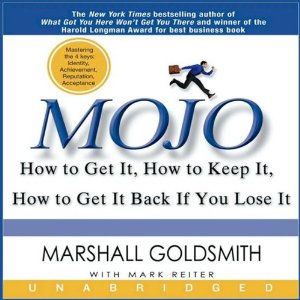Get Your Business Mojo!
Posted by Lynnea on Jul 23, 2012 in Da Blog! | 0 comments

Austin Powers got his mojo back… but what is it? Mojo is the moment when we do something that’s purposeful, powerful, and positive and the rest of the world recognizes it. This book by Marshall Goldsmith is about that moment – and how we can create it in our lives, maintain it, and recapture it when we need it.
In his follow-up to the New York Times best seller What Got You Here Won’t Get You There, number-one executive coach Marshall Goldsmith shares the ways in which to get – and keep – our Mojos. Our professional and personal Mojo is impacted by four key factors: identity (who do you think you are?), achievement (what have you done lately?), reputation (who do other people think you are – and what have you’ve done lately?), and acceptance (what can you change – and when do you need to just “let it go”?). Goldsmith outlines the positive actions leaders must take, with their teams or themselves, to initiate winning streaks and keep them coming.
Mojo is that positive spirit – towards what we are doing – now – that starts from the inside – and radiates to the outside. Mojo is at its peak when we are experiencing both happiness and meaning in what we are doing and communicating this experience to the world around us. The Mojo Toolkit provides 14 practical tools to help you achieve both happiness and meaning – not only in business, but in life.
J. Brown @ Amazon.com writes –
 Years ago a consultant I respect said “one of the most important things I have learned in dealing with clients is not finding the right answer but finding a way to communicate the right answer so they accept it”
Years ago a consultant I respect said “one of the most important things I have learned in dealing with clients is not finding the right answer but finding a way to communicate the right answer so they accept it”
I have not met Marshall Goldsmith personally but I presume he excels at this type of verbal communication because he has the rare quality to do this with the written word. This is why there is little doubt this book will be a best seller like his earlier book “What Got You Here Won’t Get You There.”
Here are just 10 excerpts from Mojo that resonated with me.
1. “The good news is that nearly all of the challenges we’ll deal with here have simple–although not easy–solutions (there is a difference between simple and easy).” Goldsmith provides these tools in the latter sections of the book.
2. “…but sometimes no matter how positive we feel about what we are doing, we fail at showing it on the outside. We are so focused on completing our task that we assume people can read our hearts and minds. We think our good intentions should be obvious. They can’t possibly be misconstrued.”
3. “…the Mojo Paradox…Our default response in life is to not experience happiness. Our default response in life is to not experience meaning. Our default response in life is to experience inertia…our most common everyday process-the thing we do more than anything else-is to continue doing what we are already doing.”
4. “Very few people achieve positive lasting change without ongoing follow-up.”
5. “As you go through your day…evaluate every activity on a 1 to 10 scale…on two simple questions. 1. How much long-term benefit or meaning did I experience from this activity? 2. How much short-term satisfaction or happiness did I experience from this activity?”
6. “One of the greatest obstacles to changing our Mojo is here-in the paralysis we create with the self limiting definitions of who we are.”
7. “…we confuse our need to consider ourselves to be smart with our need to be considered effective by the world…One of the most pernicious impulses of successful people is our overwhelming need to prove how smart we are…I say its pernicious because the need to be “the smartest person in the room” often leads to some incredibly stupid behavior.”
8. “A company named DDI did some fascinating research that showed the average American spends 15 hours a month criticizing or complaining about their boss.”
9. “These four “losing” arguments all have the same results…only lower our Mojo… 1. Let me keep talking… 2. I had it rougher than you… 3. Why did you do that… 4. It’s not fair.”
10. “If I could write a headline that sums up the last ten years of the American (and other rich country’s) workplace-and the next thirty years as well-it would be this: “That Job is Gone!” That’s the cold water I’d throw in the face of every man or woman who thinks his or her future can be understood by looking nostalgically to the past.”
Goldsmith is a master at integrating and emphasizing his points with stories. He unequivocally states in Chapter 16 “This is a self help book.”
I have learned the cost of a self help book is not the price you pay…that cost is simply out of pocket costs. The time you invest in reading and applying what is inside is the real price and this book is well worth your time and effort.
Dr. James T. Brown, PMP PE CSP
Author – The Handbook of Program Management